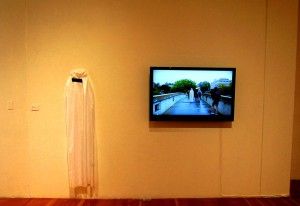
By: Nicole Block
Art can be really scary; even as someone who studies art, it can be intimidating. You step into a chilly and quiet museum where no one is talking to each other, and then you’re struggling to figure out what these works of art mean without looking like you don’t know. It can be stressful.
Older art, like that from the Renaissance or ancient Greece, usually tells a story that conveys some kind of emotion or message. It can be interpreted and deciphered if you know the historical background and culture that it comes from, and overall, the image usually contains people or places that are recognizable to some degree. Every element of the painting or sculpture has a purpose and contains a piece of the story; you can understand it on some level.
On the other hand, “modern art,” which I am using to refer to art after, say, 1950, is so strange and abstract and grounded in metaphysics that it can be utterly incomprehensible and even intolerable for some. Much of modern art is grounded in theory—of semiotics, of philosophy, of optics, of human behavior—that requires a lot of explanation and thinking outside of simply perceiving an idea from the image. The typical example is a blank white canvas that someone has called art with no explanation whatsoever and you’re left wondering why in the world this is in a museum.

Looking at our own campus as a microcosm of the art world, Claire Trevor recently held the 12th annual juried undergraduate exhibition titled: “Always Keep Footprints Between You and the Sun,” that ran from March 31 through April 16. The nine works of art filling the University Art Gallery were selected from a pool of student candidates. The two rooms of the gallery contained these works, which were done through various forms of media that were primarily pale in color and mysterious in meaning. A binder at the entrance listed the artists’ descriptions of their works, but it was hard to match those to the actual work when walking through without the reference book.
Instead, the works stood on their own, somewhat baffling without the explanation of the artists’ thinking: canvases painted white that matched the texture of the wall, a large mural-sized tarp with splotched square strokes leaning against a wall and a rectangular prism almost three feet tall made of rice and glue were just a few of the works on display. These pieces contain no figures or recognizable objects within them, and without any description they were difficult to interpret — the kind of modern art that can be written off as nonsensical.
The truth is, they aren’t nonsensical; there’s a whole story behind them just like any of Michelangelo’s world-famous paintings. Each artist has an extremely well-thought out description of their work that subtly connects back to the theme of the show—tracking an idea, a person, a goal, but also how that turns on the tracker and affects her. The description of the show states, “We are thus compelled to ponder the larger philosophical conundrum: In the game of pursuit, why is it often not clear just who is the predator and who is the prey? Are we not, in fact, equally played by the very games we purport to master?”
What I am getting at then is that modern art, however bizarre and uninviting it seems, evaluates issues and gives artists a hyper-individualized way to address it in any way they see fit. Some of these objectives are a little clearer, like Sabrina Sharifi’s video, Anonymous, that shows the artist in a handmade burka, a garment traditionally associated with Islam, to which she has added a black strip over the eyes. Wearing this burka in public places is Sharifi’s effort to question and defy the religious intolerance within Western culture.
Modern art addresses modern and age-old issues of politics, philosophy and aesthetics, so give it a chance. Check out art made by UCI students who have opinions and ideas that deserve to be expressed and heard, and most of all, remain open-minded.




